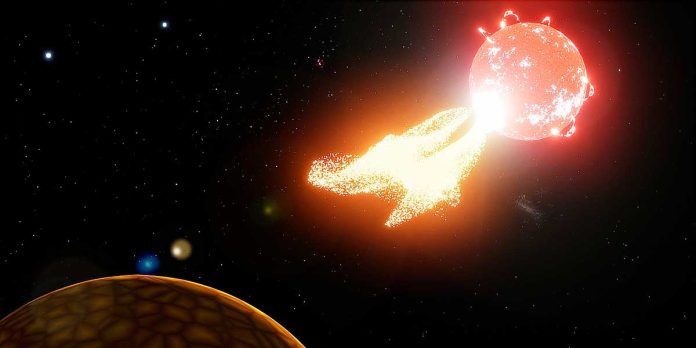If you look up in the sky (even in the city) you can see two stars, pointing towards the Southern Cross. One of these “pointers” is Alpha Centauri, which is actually a pair of Sun-like stars that are too close together to tell apart by eye.
There is a third member of the Alpha Centauri system as well: Proxima Centauri (Proxima Cen for short), which circles the central two stars in a wide orbit. This is the Sun’s nearest neighbour, at a distance of just 4.2 light years (this means it would take about 6000 years to get there, with current technology).
It is possible one of Proxima Cen’s planets is suitable for life. However, our research at the University of Sydney has detected the signature of fierce space weather from Proxima Cen, which implies any orbiting planets would be blasted with hazardous particles and magnetic fields.
Our Sun is a relatively unremarkable yellow dwarf star, hosting the only known life-bearing planet in the Universe: our Earth. Proxima Cen is very different. It is a red dwarf star, with a diameter only 15 per cent of the Sun’s, and a surface temperature of 3,000K (degrees Kelvin), much cooler than the Sun’s 6,000K.
We know Proxima Cen has at least two planets: Proxima Cen b, a rocky “super-Earth” located in the middle of Proxima Cen’s Goldilocks zone, and Proxima Cen c, a “sub-Neptune” located further out. The Goldilocks zone is what scientists call the region that has the right conditions for liquid water, and hence might be able to support life.
The “space weather” of red dwarfs is an important factor in determining how hospitable they are to life. While flares involve intense bursts of light, space weather events mean the magnetic field and charged particles from the star can interact with planets directly.
We used CSIRO’s Australian Square Kilometre Array Pathfinder telescope in Western Australia to detect a massive space weather event with an estimated total energy output of 16 septillion joules. (That’s nearly 17 million years’ worth of Australia’s current electricity output.) On the Sun, flares this big happen only once every decade. But on Proxima Cen, they happen every few weeks.
This blast of radio waves implies the space weather environment around Proxima Cen is quite violent, and the planet would be blasted regularly. So when you next look up at the Southern Cross, and think about our nearest stellar neighbour, you can be pretty confident it isn’t harbouring life as we know it.
_______________
This story by Tara Murphy and Andrew Zic is based on this article: https://theconversation.com/bad-space-weather-may-make-life-impossible-near-proxima-centauri-150979





